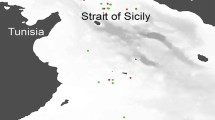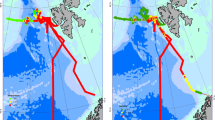Abstract
Since the early 2000s routine fish surveys have recorded increasing numbers of snake pipefish, Entelurus aequoreus, in the northeast Atlantic. Fishermen and divers have also commented on this increase and pipefish have started to appear in the diet of seabirds and other marine predators. This paper collates information from these diverse sources and assesses the current status of snake pipefish. We found compelling evidence of a dramatic increase in the abundance of snake pipefish starting around 2003 and continuing up to the present (2006) and a range expansion northwards to Spitzbergen and the Barents Sea. Since 2004 snake pipefish have been increasingly recorded in the diet of many species of seabird breeding in colonies around the coast of the UK, and in Norway, Iceland and the Faeroe Islands. Information on the nutrient value of snake pipefish is currently lacking but their rigid, bony structure makes them difficult for young seabirds to swallow and there are numerous records of chicks choking to death. Thus, in the case of avian predators during the breeding season, it appears unlikely that increased abundance of snake pipefish will provide a useful alternative prey. The reason for the rapid and dramatic increase in numbers of snake pipefish is currently unclear but such events are characteristic of marine ecosystems and will almost certainly have an effect on food web dynamics.




Similar content being viewed by others
References
Anker-Nilssen T, Aarvak T (2006) Long-term studies of Atlantic puffins and other seabirds in the municipality of Røst, Nordland. Norwegian Institute for Nature Research, NINA Rapport 133, Trondheim
Anon (2004) Report of the study group on survey trawl gear for the IBTS western and southern areas. International Council for the Exploration of the Sea, ICES CM 2004/B:01 Ref. G
Backus RH, Craddock JE, Haedrich RC, Robison BH (1977) Altlantic mesopelagic zoogeography Fishes of the Western North Atlantic, Part 7. Sears Foundation for Marine Research, Yale University, pp 266–287
Bakun A (2006) Wasp-waist populations and marine ecosystem dynamics: navigating the “predator pit” topographies. Prog Oceanogr 68:271–188
Beare DJ, Batten SD, Edwards M, Reid DG (2002) Prevalence of boreal Atlantic, temperate Atlantic and neritic zooplankton in the North Sea between 1958 and 1998 in relation to temperature, salinity, stratification intensity and Atlantic inflow. J Sea Res 48:29–49
Beare DJ, Burns F, Greig A, Jones EG, Peach K, Kienzle M, McKenzie E, Reid DG (2004) Observations on long-term changes in prevalence of fish with southern biogeographic affinities in the North Sea. Mar Ecol Prog Ser 284:269–279
Beare DJ, Burns F, Jones EG, Peach K, Reid DG (2005) Red mullet migration into the northern North Sea during late winter. J Sea Res 53:205–212
Beaugrand G (2003) Long-term changes in copepod abundance and diversity in the north-east Atlantic in relation to fluctuations in the hydroclimatic environment. Fishe Oceanogr 12(4, 5):270–283
Becker PH, Frank D, Walter U (1987) Geographische und jährliche variation der Ernährung der Flußseeschwalbe (Sterna hirundo) an der Nordseeküste. J Ornithol 128:457–475
Damm P, Hinzpeter H, Luthardt H, Terzenbach U (1994) Seasonal and interannual variability in the atmosphere and in the sea. In: Sündermann J (eds) Circulation and contaminant fluxes in the North Sea. Springer, Berlin, pp 11–55
Dawson CE (1986) Syngnathidae. In: Whitehead PJP, Bauchot ML, Hureau JC, Nielsen J, Tortonese E (eds) Fishes of the north-eastern Atlantic and the Mediterranean. UNESCO, Paris, pp 628–639
Dietrich G, Kalle K, Krauss W, Siedler G (1975) Allgemeine Meereskunde. 3. Auflage. Borntraeger, Borntraeger
Frick S, Becker PH (1995) Unterschiedliche Ernährungsstraategien von Fluß- und Kusterseeschwalbe (Sterna hirundo und S. paradisaea) im Wattermeer. J Ornithol 136:47–63
Harris MP (1984) The Puffin. T. and A.D. Poyser, Staffordshire, England
Harris MP (2006) Seabirds and pipefish: a request for records. Brit Birds 99:148
Harris MP, Wanless S (1985) Fish fed to young Guillemots, Uria aalge, and used in display on the Isle of May, Scotland. J Zool, London 207:441–458
Heath MR, Astthorsson OS, Dunn J, Ellertsen B, Gaard E, Gislason A, Gurney WSC, Hind AT, Irigoien X, Melle W, Niehoff B, Olsen K, Skreslet S, Tande KS (2000) Comparative analysis of Calanus finmarchicus demography at locations around the Northeast Atlantic. ICES J Mar Sci 57:1562–1580
Kirby RK, Johns DG, Lindley JA (2006) Fathers in hot water: rising sea temperatures and a Northeastern Atlantic pipefish baby boom. Biol lett online 2:597–600
Kloppmann MHF, Ulleweit J (2006) Off-self distribution of pelagic snake pipefish, Entelurus aequoreus (Linnaeus, 1758), west of the British Isles. Mar Biol. DOI 10.1007/s00227-006-0480-4
Lewis S, Wanless S, Wright PJ, Harris MP, Bull J, Elston DA (2001) Diet and breeding performance of black-legged kittiwakes Rissa tridactyla at a North Sea colony. Mar Ecol Prog Ser 221:277–284
Lumsden WHRH AJ (1946) The food of the shag (Phalacrocorax aristotelis) in the Clyde area. J Anim Ecol 15:35–42
Martin AR (1989) The diet of Atlantic puffin Fratercula arctica and Northern gannet Sula bassana chicks at a Shetland colony during a period of changing prey availability. Bird Study 36:170–180
Mavor RA, Parsons M, Heubeck M, Schmitt S (2005) Seabird numbers and breeding success in Britain and Ireland, 2004. Joint Nature Conservation Committee, Peterborough (UK Nature Conservation No.28)
Mavor RA, Parsons M, Heubeck M, Schmitt S (2006) Seabird numbers and breeding success in Britain and Ireland, 2005. Joint Nature Conservation Committee, UK Nature Conservation No. 30, Peterborough
Monaghan P (1992) Seabirds and sandeels: the conflict between exploitation and conservation in the northern North Sea. Biodivers Conserv 1:98–111
Money S (2005) St kilda seabird and marine ranger annual report 2005. National Trust for Scotland, Edinburgh
Newell M (2006) A moribund young kittiwake surrounded by snake pipefish. Brit Birds 99:500–501
Perry AL, Low PJ, Ellis JR, Reynolds JD (2005) Climate change and distribution shifts in marine fishes. Science 308:1912–1915
Planque B, Fromentin J-M (1996) Calanus and environment in the eastern North Atlantic. 1. Spatial and temporal patterns of C. finmarchicus and C. helgolandicus. Mar Ecol Prog Ser 134:101–109
Planque B, Taylor AH (1998) Long-term changes in zooplankton and the climate of the North Atlantic. ICES J Mar Sci 55:644–654
Safina C, Wagner RH, Witting DA, Smith KJ (1990) Prey delivered to roseate and common tern chicks; composition and temporal variability. J Field Ornithol 61:331–338
Sonntag N, Hüppop O (2005) Snacks from the depth; summer and winter diet of common Guillemots Uria aalge around the island of Helgoland. Atlantic Seabirds 7:1–14
Vauk G, Jokele I (1975) Vorkommen, Herkunft und Winternahrung Helgoländer Dreizehenmöwen (Rissa tridactyla). Veröffenlichungen Instituts für Meeresforschung Bremerhaven 15:69–77
Wakefield E (2005) Seabird and marine mammal observations onboard the RSS Charles Darwin during British Geological Survey cruise CD174 in the Rockall Trough, August-September 2005. Report to the DTI as part of SEA7. British Antarctic Survey, Cambridge
Wheeler A (1978) Key to the fishes of Northern Europe. Warne, London
Acknowledgments
We thank the many scientists, technicians, seamen, divers and birdwatchers who collected the data that we summarize in this paper, the ICES for kindly for allowing us access to the DATRAS database and the European Union for helping fund marine data collection.
Author information
Authors and Affiliations
Corresponding author
Additional information
Communicated by R. Cattaneo-Vietti, Genova.
Rights and permissions
About this article
Cite this article
Harris, M.P., Beare, D., Toresen, R. et al. A major increase in snake pipefish (Entelurus aequoreus) in northern European seas since 2003: potential implications for seabird breeding success. Mar Biol 151, 973–983 (2007). https://doi.org/10.1007/s00227-006-0534-7
Received:
Accepted:
Published:
Issue Date:
DOI: https://doi.org/10.1007/s00227-006-0534-7




